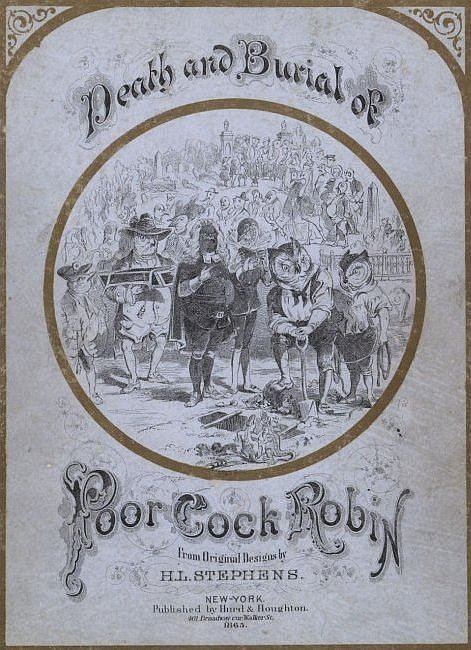Published c. 1744 | ||
 | ||
"Who Killed Cock Robin" is an English nursery rhyme, which has been much used as a murder archetype in world culture. It has a Roud Folk Song Index number of 494.
Contents
Lyrics
The earliest record of the rhyme is in Tommy Thumb's Pretty Song Book, published c. 1744, which noted only the first four verses. The extended version given below was not printed until c. 1770.
Who saw him die?I, said the Fly,with my little eye,I saw him die.Who caught his blood?I, said the Fish,with my little dish,I caught his blood.Who'll make the shroud?I, said the Beetle,with my thread and needle,I'll make the shroud.Who'll dig his grave?I, said the Owl,with my little trowel,I'll dig his grave.Who'll be the parson?I, said the Rook,with my little book,I'll be the parson.Who'll be the clerk?I, said the Lark,if it's not in the dark,I'll be the clerk.Who'll carry the link?I, said the Linnet,I'll fetch it in a minute,I'll carry the link.Who'll be chief mourner?I, said the Dove,I mourn for my love,I'll be chief mourner.Who'll carry the coffin?I, said the Kite,if it's not through the night,I'll carry the coffin.Who'll bear the pall?We, said the Wren,both the cock and the hen,We'll bear the pall.Who'll sing a psalm?I, said the Thrush,as she sat on a bush,I'll sing a psalm.Who'll toll the bell?I said the Bull,because I can pull,I'll toll the bell.All the birds of the airfell a-sighing and a-sobbing,when they heard the bell tollfor poor Cock Robin.The rhyme has been often reprinted with illustrations, as suitable reading material for small children. The rhyme also has an alternative ending, in which the sparrow who killed cock robin is hanged for his crime. Several early versions picture a stocky, strong-billed bullfinch tolling the bell, which may have been the original intention of the rhyme.
Origin and meaning
Although the song was not recorded until the mid-eighteenth century, there is some evidence that it is much older. The death of a robin by an arrow is depicted in a 15th-century stained glass window at Buckland Rectory, Gloucestershire, and the rhyme is similar to a story, Phyllyp Sparowe, written by John Skelton about 1508. The use of the rhyme 'owl' with 'shovel', could suggest that it was originally used in older middle English pronunciation. Versions of the story appear to exist in other countries, including Germany.
A number of theories have been advanced to explain the meaning of the rhyme:
All of these theories are based on perceived similarities in the text to legendary or historical events, or on the similarities of names. Peter Opie pointed out that an existing rhyme could have been adapted to fit the circumstances of political events in the eighteenth century.
The theme of Cock Robin's death as well as the poem's distinctive cadence have become archetypes, much used in literary fiction and other works of art, from poems, to murder mysteries, to cartoons.
